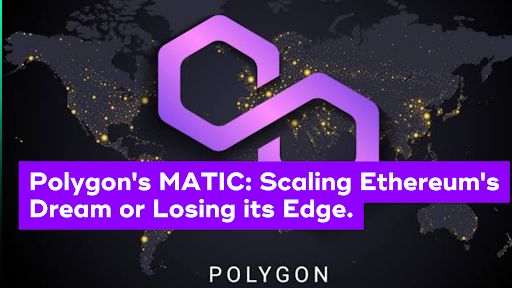Polygon in 2025: Still Scaling Ethereum—or Just Spinning Plates?
MATIC trades at $0.71 with a $7.1 billion market cap (CoinMarketCap, June 5, 2025). That’s a far cry from its 2021 high of $2.92, but it’s still standing, still shipping, still moving volume. Polygon’s processing over 7 million transactions a day (PolygonScan). Ethereum? Around 1 million.
It’s easy to forget how important Polygon’s been to Ethereum’s scaling story. It handled the fees when L1 got too expensive. It hosted the dApps when users bailed on mainnet. But the market’s twitchy. A 10% price drop in May. New L2 players moving fast. Posts on X are bullish one day, skeptical the next.
The real question: can Polygon keep the lead—or is it quietly losing the plot?
What Polygon Still Gets Right
Polygon’s been in the trenches longer than most of its competition. It’s a sidechain, technically, but the performance speaks for itself—fees under a penny, speeds that make Ethereum look prehistoric, and a dApp ecosystem that includes Aave, OpenSea, and Uniswap.
At its peak, it had the story and the volume to back it up. TVL’s still sitting at $4.5 billion (DefiLlama). Not bad in a bear-heavy market. There are over 1,800 dApps deployed. Starbucks and Nike built on Polygon. Reddit’s NFTs are here. It’s not theory—it’s shipping.
Then came AggLayer. Launched in 2024, it’s Polygon’s attempt to stitch together L2s and rollups into a single, liquid system. One wallet, one interface, many chains. If it works, it’s a huge unlock for Web3. And it positions Polygon as the router—not just a layer, but the switchboard.
zkEVM is also live. It’s not perfect yet, but it brings real ZK rollup tech into Ethereum compatibility. And it’s working alongside the main chain—not instead of it.
According to a 2025 Messari report, Polygon still clears 40% of all Ethereum L2 transaction volume. That’s not nothing.
But the Pressure’s Mounting
Let’s talk competition.
Arbitrum has taken the TVL crown—$6 billion and growing. zkSync is faster, cheaper, and built on real zero-knowledge rails. Optimism has the Coinbase bump. Polygon’s lead? It’s looking thin.
The tech edge is fading. zkSync’s been rolling out updates faster than anyone expected. Arbitrum has new liquidity incentives dropping almost every month. Polygon’s stuck managing expectations. It’s shipping—yes—but the pace doesn’t feel aggressive anymore.
And then there’s the validator debate. Polygon still runs on a permissioned set of about 100 validators. Many are corporate-run. That’s rubbed decentralization maxis the wrong way. Sidechain security has always been a tradeoff, but now it’s getting more attention.
A DeFi trader at Devcon 2025 said it straight: “Polygon’s fast, but it’s not Ethereum. You’re always taking a trust hit.”
Tokenomics don’t help. Total supply? 10 billion MATIC. Inflation since 2021? 20%. It’s a long-term dilution problem that traders don’t like to talk about—but whales are watching. And it’s showing up in the market.
The Numbers Don’t Lie, But They Don’t Scream Bull Either
Let’s look at the breakdown:
| Protocol | TVL | Daily Txns | Notable Use Cases |
| Polygon | $4.5B | 7M | Aave, OpenSea, DeFi games |
| Arbitrum | $6B | 5M | Rapid liquidity growth |
| Optimism | $3B | 2M | Base chain w/ Coinbase tie |
Daily active addresses on Polygon hit 1.2 million in Q1 2025 (PolygonScan). That’s up 30% YoY. But Binance funding rates flipped bearish in May. There’s volume, but not conviction.
Whales holding 10M+ MATIC are still adding. That’s real. But it doesn’t change the fact that short-term bets are stacking against it.
Land sales on Decentraland—built on Polygon—are still happening. $5 million monthly volume, on-chain. So there’s usage. But the broader market wants more than just usage. It wants edge.
Can Polygon Hold Its Ground?
AggLayer is the wildcard. If it delivers—if it becomes the API layer for Ethereum’s rollups—Polygon will matter no matter how the L2 wars shake out. It doesn’t need to beat Arbitrum or zkSync. It just needs to connect them.
But that’s a big “if.”
The roadmap is dense. Integrations take time. And while Polygon talks big, others are quietly deploying. If zkSync nails developer onboarding and Arbitrum keeps shipping L3s, Polygon’s moat shrinks. Fast.
Then there’s Ethereum itself. If sharding becomes real by 2026, Layer-2 scaling may not need Polygon-style sidechains anymore. Cheaper mainnet fees = less reason to leave home base. That’s not a death sentence, but it’s a sharp downgrade to Polygon’s value prop.
And let’s not forget—Polygon had a validator exploit in 2021. $2M was lost. Not catastrophic, but it’s a warning. Another one like that in today’s market? People would move. Fast.
Final Word: Not Out, But Not Coasting
Polygon’s not washed. Let’s be clear about that.
It’s processing more transactions than almost any chain. It has real dApps. It’s trying to scale Ethereum in ways Ethereum still can’t do for itself. And its tech stack is serious—zkEVM, PoS, AggLayer. It’s building.
But the space is moving fast. Token inflation is real. Validator decentralization is still a question. And the competition? It’s not waiting.
MATIC is still a top asset. But holding it now means betting that Polygon can shift—fast—and stay relevant as the landscape changes.
Can it win the long game? Maybe. But this won’t be a smooth ride.

Steve Gregory is a lawyer in the United States who specializes in licensing for cryptocurrency companies and products. Steve began his career as an attorney in 2015 but made the switch to working in cryptocurrency full time shortly after joining the original team at Gemini Trust Company, an early cryptocurrency exchange based in New York City. Steve then joined CEX.io and was able to launch their regulated US-based cryptocurrency. Steve then went on to become the CEO at currency.com when he ran for four years and was able to lead currency.com to being fully acquired in 2025.


